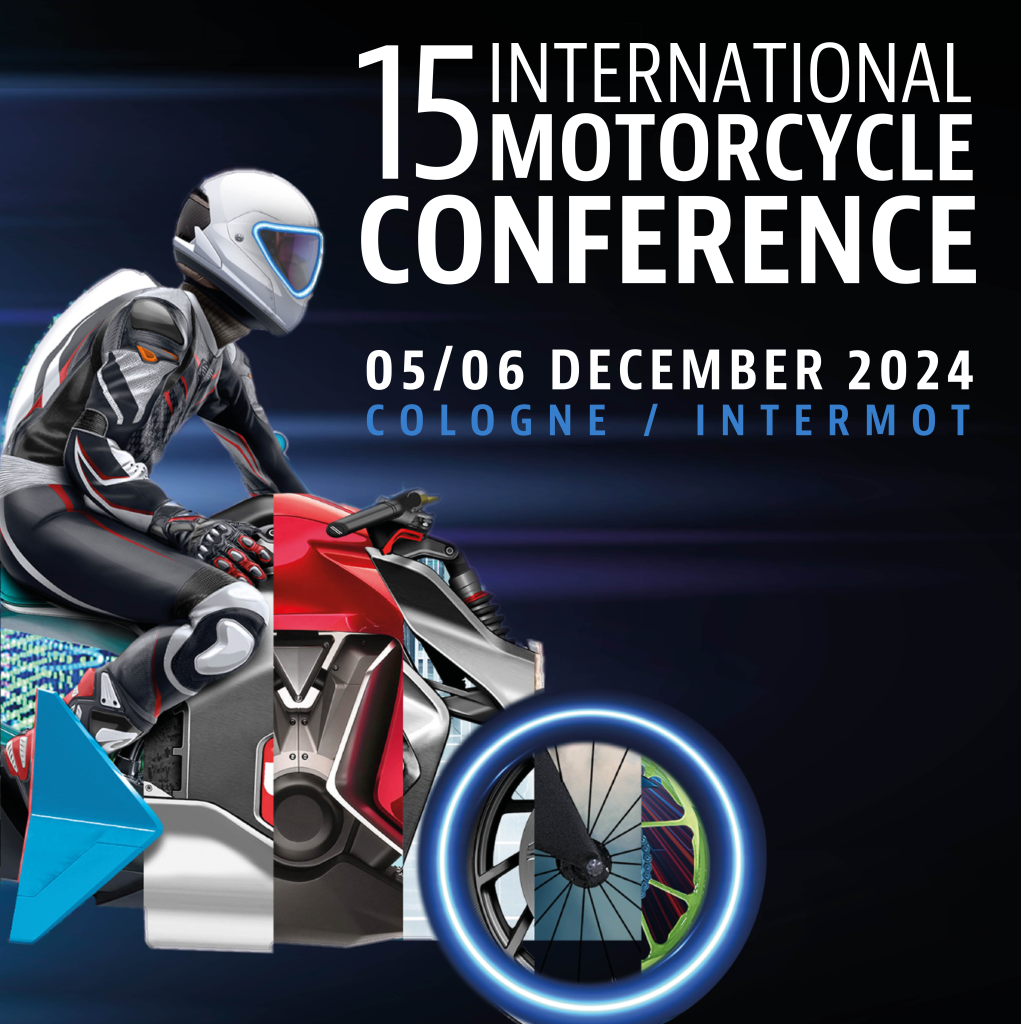Beiträge
Active motorcycle safety with Rider Assistance Systems – BASt research
Aktive Motorradsicherheit durch Fahrerassistenz – Forschung der BASt
Julia Bräutigam
Federal Highway Research Institute (Bast), Germany
Bundesanstalt für Straßenwesen (BASt)
Motorcycle Safety in Germany: Attitudes and Behavior with special view on Advanced Rider Assistance Systems for Powered Two Wheelers
Motorradsicherheit in Deutschland: Einstellungen und Verhaltensweisen mit speziellem Blick auf Fahrer-Assistenzsysteme an Krafträdern
André Vallese
Institute for Motorcycle Safety (ifz), Germany
Institut für Zweiradsicherheit (ifz)
Development of a Surrogate Motorcycle Soft Target for Use in ADAS Testing
Entwicklung eines Motorrad-Models für Tests mit Fahrer-Assistenzsystemen
John Lenkeit
Dynamic Research Inc., USA
Safety Potential Assessment of Cornering ABS Systems Based On Riding Tests
Begutachtung des Sicherheitspotenzials von Kurven-ABS-Systemen basierend auf Praxistests
Alessio Sevarin
Vehicle Safety Institute, Graz University of Technology, Austria
Institut für Fahrzeugsicherheit, Technische Universität Graz
Limits of Autonomous Emergency Brake Systems for Powered Two-Wheelers – An Expert Study
Einsatzgrenzen automatischer Notbremssysteme für motorisierte Zweiräder – eine Expertenstudie
Nora Leona Merkel
Technische Universität Darmstadt, Institute of Automotive Engineering (FZD), Germany
Technische Universität Darmstadt, Fachgebiet Fahrzeugtechnik (FZD)
The Influence of Rider Motion on Motorcycles and Riding Simulators
Einfluss der Fahrerbewegung auf Realfahrzeug und Motorradsimulator
Raphael Pleß
Technische Universität Darmstadt, Institute of Automotive Engineering (FZD), Germany
Technische Universität Darmstadt, Fachgebiet Fahrzeugtechnik (FZD)
Preventing Lateral Sliding in Curves
Verhinderung seitlichen Rutschens in Kurven
Matthias Klews
Robert Bosch GmbH, Germany
Why automatization is the future of rider assistance systems – Intervene before a critical situation.
Warum Automatisierung die Zukunft für Assistenzsysteme ist – Intervenieren, bevor es kritisch wird.
Stefan Hans, BMW Motorrad, Germany
Markus Köbe, Günther Prokop, Technische Universität Dresden, Germany
CMC-Roadmap: motorcycles on track to connectivity & Evaluation of the Potential of C-ITS for Motorcycles on the Basis of Real Accidents
CMC-Roadmap: Das Motorrad auf dem Weg zur Konnektivität & Bewertung des Potentials von C-ITS für motorisierte Zweiräder auf Basis von Realunfalldaten
Christian Massong, BMW Motorrad, Germany
Marcus Petzold, Verkehrsunfallforschung an der TU Dresden (VUFO), Germany
Powered Two Wheeler HMI Design For Cooperative Intelligent Transport Systems (C-ITS)
Motorrad HMI Design für Cooperative Integlligent Transport Systems (C-ITS)
Sebastian Will
Würzburg Institute for Traffic Sciences, Germany
Würzburger Institut für Verkehrswissenschaften (WIVW)
Comparing critical event deceleration for motorcyclists and drivers
Im Vergleich: Verhalten in kritischen Situationen von Motorrad- und Pkw-Fahrern
Shane McLaughlin
Virginia Tech Transportation Institute, USA
Detection of motorcyclists by car drivers with and without motorcycling experience.
A virtual reality driving simulator study including eye-tracking.
Wahrnehmung von Motorrädern durch Pkw-Fahrer mit und ohne Motorrad-Erfahrung.
Eine Virtual-Reality-Simualtorstudie unter Berücksichtigung des Blickverhaltens.
Sofie Boets
VIAS institute, Belgium
The proposed approach of Knowledge Base for the identification of promising countermeasures to reduce casualties amongst motorcyclists
Der Ansatz einer Wissensbasis für die Identifikation von zielführenden Gegenmaßnahmen zur Reduzierung von Motorradunfällen
Giovanni Savino
Department of Industrial Engineering (DIEF), Universityof Florence, Italy
The International Motorcycling Federation sets a new standard for riders‘ safety through the FIM Racing Homologation Programme for helmets.
Mit dem FIM-Racing Homologation Programm für Motorradhelme setzt die FIM einen neuen Standard für Fahrersicherheit
Erica Manfredi
Fédération Internationale de Motocyclisme (FIM), Switzerland
Virtual assessment of protective systems for motorcyclists based on real-world accident-data
Realunfalldaten-basierte virtuelle Bewertung von Schutzsystemen für Motorradfahrer
Klaus Bauer
Ludwig Maximilian University Munich, Biomechanics and Accident Analysis at Institute of Legal Medicine Germany
Ludwig-Maximilians-Universität München, Biomechanik und Unfallforschung am Institut für Rechtsmedizin.
Safety Standard for Motorcyclists – Protection against Injuries in Traffic Accidents and Residual Injury Pattern.
Sicherheitsstandard für Motorradfahrer- Schutz gegen Verletzungen in Verkehrsunfällen und Bilanz verbliebener Verletzungsschwerpunkte
Dietmar Otte
BIOMED-TEC Hannover and Hannover Medical School, Germany
BIOMED-TEC Hannover und Medizinische Hochschule Hannover, Germany
ADAS&ME: Experiments for the development of a rider condition monitoring system
ADAS&ME: Experimente zur Entwicklung eines Monitoring-Systems für die Verfassung des Fahrers.
Ioannis Symeonidis
Hellenic Institute of Transport, Centre for Research & Technology Hellas, Greece
Different approaches with regard to safe cornering lines and how to adopt them – background information and possible improvements
Unterschiedliche Ansätze sicherer Kurvenfahrlinien und deren Aneignung – Hintergründe und mögliche Verbesserungen
Roman Angermann
Swiss Touring Club, Switzerland
Touring Club Schweiz
Lean Angles and Lane Positions of Motorcyclists
Schräglagen und Kurvenlinien von Motorradfahrern
Martin Winkelbauer
Austrian Road Safety Board, Austria
Kuratorium für Verkehrssicherheit (KFV)
High Precision Motorcycle Bend Trajectory Reconstruction Based on a Low-cost Multi-Sensor System
Die hochpräzise Nachabbildung von Motorrad-Kurvenlinien basierend auf einem kostengünstigen Multi-Sensorsystem
Sarra Smaiah
Laboratoire Signal et Communication, Algeria
Laboratoire Systèmes et Applications des Technologies de l’Information et de l’Energie, Université Paris Sud, France
The DVR Smart Phone Riding Style Feedback Application
Die DVR-Smartphone-Feedback-Applikation für den Fahrstil
Hartmut Kerwien, Institut für angewandte Verkehrspädagogik (avp), Germany
Kay Schulte, German Road Safety Council, Germany
Deutscher Verkehrssicherheitsrat (DVR)
New ways to measure motorcycle safety – by means of risk modelling and analyzing riding dynamics data
Neue Wege um Motorradsicherheit zu messen – anhand von Risikomodellen und der Analyse von Fahrdynamikdaten
Christian Stefan, Klemens Schwieger
Austrian Institute of Technology GmbH (AIT), Austria
Innovative motorcycle headlight design for improving motorcycle visibility
Innovatives Motorrad Scheinwerferdesign für bessere Erkennbarkeit
Stéphane Espié
The French institute of science and technology for transport, development and networks (IFSTTAR), France
Ultra-lightweight electric two-wheelers are the future; the future is now.
Ultraleichte elektrische Zweiräder sind die Zukunft; die Zukunft ist jetzt.
Steven H. Anderson
MEA Forensic Engineers & Scientists, USA


